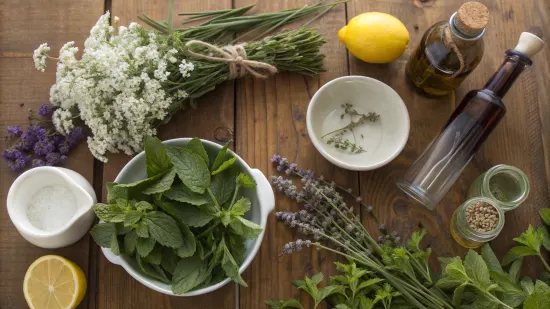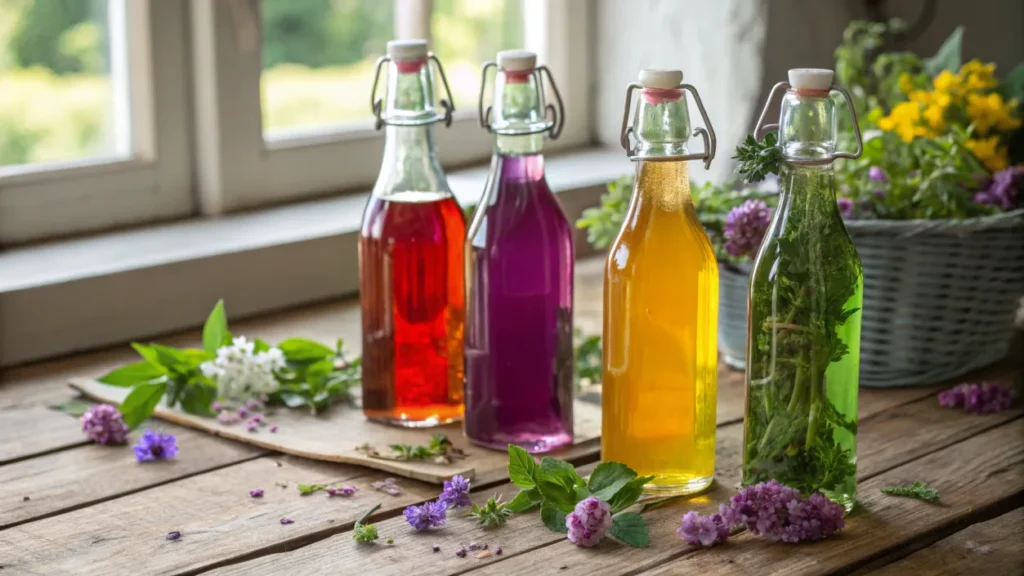Herbal Cordial Recipe – Why This Recipe?
As Chef Greeny, I’ve always been fascinated by the magical transformation that happens when herbs steep in sweetened liquid, creating something entirely more magnificent than the sum of its parts. My journey with herbal cordials began during a particularly hot summer in my grandmother’s garden. Overwhelmed by an abundance of mint, lemon balm, and elderflowers, she taught me how to preserve their essence in cordials that would brighten our drinks long after summer had passed.
What makes these herbal cordial recipes special is their versatility and simplicity. Using just a handful of ingredients—fresh herbs, sugar, water, and sometimes citrus—you can create concentrated syrups that add complex flavors to everything from sparkling water to cocktails. Unlike commercial cordials loaded with artificial ingredients, these homemade versions capture the true essence of herbs while giving you complete control over sweetness and flavor intensity.
In this guide, you’ll learn how to make seven distinct herbal cordials, from classic elderflower to unexpected combinations like lavender-honey. I’ll share the techniques that ensure vibrant flavors, tips for storage, and creative ways to use your homemade creations beyond the obvious.
Herbal Cordial Recipe – Ingredients and Preparation
Ingredients List

Base Cordial Recipe (Adaptable for All Variations)
- 4 cups fresh herbs or flowers (specific to each recipe)
- 4 cups granulated sugar
- 2 cups water
- 2-3 unwaxed lemons or limes (zest and juice)
- 2 tablespoons citric acid (optional, helps preservation)
Substitution Options:
- For sugar-free versions: Replace sugar with monk fruit sweetener (use 2-3 cups as it’s sweeter than sugar)
- For vegan concerns: All recipes are naturally vegan
- For citric acid: Can substitute with 1/4 cup additional lemon juice
Step-by-Step Instructions
- Prepare your herbs. Rinse them gently under cool water to remove any dirt or insects. For flowers like elderflower or lavender, shake them gently (don’t wash) to remove any insects. Pat dry with paper towels. Remove any woody stems or discolored leaves. Tip: Harvest herbs in the morning after the dew has dried but before the heat of the day, when their essential oils are most concentrated.
- Prepare your citrus. Wash lemons or limes thoroughly. Using a vegetable peeler or zester, remove the colored part of the peel, avoiding the bitter white pith. Slice the fruit and squeeze to extract the juice. Tip: Roll citrus firmly on the counter before juicing to break down interior membranes and extract more juice.
- Combine water and sugar in a large saucepan. Heat gently, stirring constantly until the sugar completely dissolves. Do not allow the mixture to boil, as this can create a cloudy cordial. Tip: For a clearer cordial, use a candy thermometer and keep the temperature below 190°F (88°C).
- Remove from heat once sugar is dissolved. Add the prepared herbs, citrus zest, juice, and citric acid (if using). Stir to combine. Tip: Bruising herbs slightly with a wooden spoon before adding them releases more aromatic oils.
- Cover and steep. Place a lid on the saucepan and allow the mixture to steep for 24-48 hours in a cool, dark place. Tip: The longer you steep, the stronger the flavor, but beyond 48 hours some herbs can develop bitter notes.
- Strain the cordial through a fine-mesh sieve lined with cheesecloth or a coffee filter. Press gently on the solids to extract all the liquid. Tip: For ultimate clarity, avoid pressing too hard on the solids, which can push cloudy particles into your cordial.
- Bottle and store. Using a funnel, pour the strained cordial into sterilized glass bottles. Seal tightly. Tip: Sterilize bottles by washing thoroughly and placing in an oven at 275°F (135°C) for 20 minutes.
Notes and Tips
- Storage: Properly sealed cordials will keep for up to 6 months in the refrigerator. For longer storage, add an extra tablespoon of citric acid or process bottles in a water bath.
- Serving Suggestions: Dilute cordial with still or sparkling water at a ratio of 1:4 (cordial to water). For cocktails, use 1-2 tablespoons per drink as a flavoring syrup.
- Make-Ahead Instructions: Cordials actually improve with a week or two of “resting” time, allowing flavors to mellow and develop complexity.
Herbal Cordial Recipe – Nutritional Information

Nutrition Facts (Per Serving – 2 Tbsp)
- Calories: (~50)
- Carbohydrates: (13g)
- Protein: (0g)
- Total Fat: (0g)
- Saturated Fat: (0g)
- Unsaturated Fat: (0g)
- Trans Fat: (0g)
- Fiber: (0g)
- Sugar: (13g)
- Cholesterol: (0mg)
- Sodium: (0mg)
Note: Nutritional values are approximate and based on the base recipe. Values may vary slightly depending on specific herbs used.
Herbal Cordial Recipe – History and Cultural Significance
Cordials have a rich history dating back to medieval times, when they were originally created as medicinal tonics. The word “cordial” comes from the Latin “cor” or “cordis,” meaning heart, as these sweet, herb-infused drinks were believed to stimulate and strengthen the heart and spirit.
In the 16th and 17th centuries, cordials evolved from purely medicinal preparations to pleasurable drinks enjoyed by the upper classes. Elderflower cordial became particularly popular in Victorian England, where it was a staple at garden parties and afternoon teas.
Different regions developed their own signature cordials based on local herbs and traditions. In Scandinavia, elderflower cordial (fläderblomssaft) marks the beginning of summer, while Mediterranean cultures often created cordials from herbs like rosemary and thyme, sometimes incorporating local citrus.
What we now call cordials varies by region. In the UK and Australia, cordials are non-alcoholic concentrated syrups diluted with water. In the US, “cordial” often refers to sweet liqueurs, while the non-alcoholic versions are typically called “syrups.”
Herbal Cordial Recipe – Creative Variations
1. Classic Elderflower Cordial
The quintessential summer cordial with a delicate, floral flavor.
- Special Ingredients: 30-40 elderflower heads (in place of the 4 cups herbs)
- Unique Step: Shake flowers to remove insects but don’t wash them, as this removes the natural yeasts that contribute to flavor.
- Serving Suggestion: Mix with prosecco for an elegant aperitif.
2. Mint-Lime Cooler Cordial
A refreshing option perfect for hot summer days.
- Special Ingredients: 3 cups fresh mint leaves, 1 cup lime juice (instead of lemon), 2 tablespoons lime zest
- Unique Step: Bruise mint leaves thoroughly before steeping to release essential oils.
- Low-Sugar Version: Reduce sugar to 2 cups and add 10 drops of liquid stevia for sweetness without the calories.
3. Lavender-Honey Cordial
A soothing, aromatic cordial with floral notes.
- Special Ingredients: 2 cups fresh lavender flowers, 2 cups sugar, 2 cups raw honey (replacing half the sugar)
- Unique Step: Use a lower steeping temperature (around 170°F/77°C) to preserve the delicate lavender aroma.
- Serving Suggestion: Add a splash to hot tea for a calming evening drink.
Herbal Cordial Recipe – Frequently Asked Questions

Can I freeze herbal cordial instead of bottling it? Yes! Cordials freeze exceptionally well. Leave about an inch of headspace in freezer-safe containers as the liquid will expand. Frozen cordials maintain quality for up to a year. Alternatively, freeze in ice cube trays for convenient single-serving portions.
What can I substitute for citric acid? If you can’t find citric acid, increase the lemon juice by 1/4 cup. Another option is to use 2 tablespoons of lemon salt (citric acid sold for cooking) or 3 tablespoons of white vinegar, though this will slightly alter the flavor profile.
How long does it take to prepare herbal cordial? Active preparation time is approximately 30-45 minutes. However, the steeping process requires 24-48 hours, and the cordial benefits from at least a week of “resting” time for optimal flavor development.
Why has my cordial crystallized? Crystallization occurs when the sugar-to-liquid ratio is too high. To fix crystallized cordial, gently reheat the bottle in a warm water bath and add a small amount of boiled and cooled water to dissolve the crystals.
Can I use dried herbs instead of fresh? Yes, but with adjustments. Use about 1/3 the amount of dried herbs compared to fresh (approximately 1 1/3 cups instead of 4 cups), as dried herbs have more concentrated flavor. The resulting cordial may have a slightly different color and flavor profile.
Herbal Cordial Recipe – Final Thoughts
Creating your own herbal cordials connects you to centuries of tradition while allowing for creative experimentation with flavors. Whether you’re preserving the bounty of your garden, seeking healthier alternatives to commercial drinks, or simply expanding your culinary repertoire, homemade cordials offer endless possibilities.
The beauty of these recipes lies in their adaptability—once you understand the basic technique, you can apply it to virtually any herb or edible flower. Don’t be afraid to combine unexpected flavors or adjust sweetness levels to suit your taste.
I hope these seven herbal cordial recipes inspire you to start your own cordial-making tradition. There’s something deeply satisfying about capturing seasonal flavors in a bottle, ready to brighten drinks throughout the year. I’d love to hear about your cordial-making adventures—leave a comment with your favorite herb combination or how you’ve used your homemade cordials in creative ways!
As summer progresses and different herbs come into season, your cordial repertoire can expand along with the changing garden. From the delicate floral notes of spring to the robust aromatics of late summer, each bottle captures a moment in time, ready to be remembered with every sip.
For more on the fascinating history of herbal preparations throughout history, check out this comprehensive Wikipedia article on herbal medicine.





1 thought on “Herbal Cordial Recipe: 7 Delightful Ideas to Transform Your Summer Drinks”